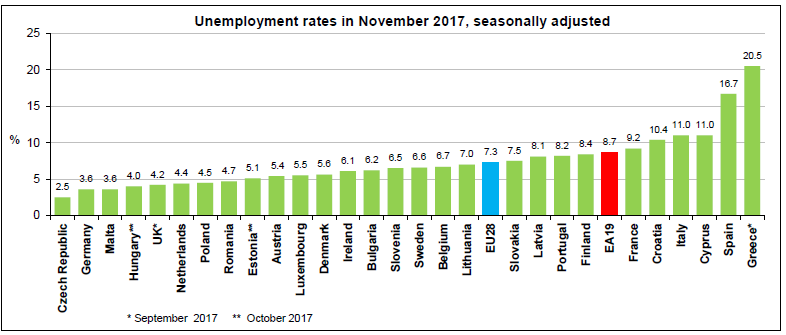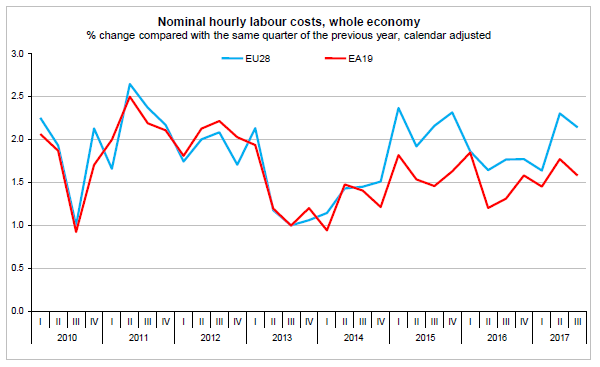Eurostat/Euro area unemployment at 8.7%/9 January 2018 The euro area (EA19) seasonally-adjusted unemployment rate was 8.7% in November 2017, down from 8.8% in October 2017 and from 9.8% in November 2016. This is the lowest rate recorded in the euro area since January 2009. The EU28 unemployment rate was 7.3% in November 2017, down from 7.4% in October 2017 and from 8.3% in November 2016. This is the lowest rate recorded in the …Read More
Will Monetary Policy Trigger Another Financial Crisis?
Alexander Friedman, (2017), “Will Monetary Policy Trigger Another Financial Crisis?”, Project Syndicate, 21 December Sustained unconventional monetary policies in the years after the 2008 global financial crisis created the conditions for the second-longest bull market in history. But they also may have sown the seeds of the next financial crisis, which might take root as central banks continue to normalize their policies and shrink their balance sheets. Relevant Posts Michael …Read More
The World Economy in 2018
Michael J. Boskin (2017), “The World Economy in 2018”, Project Syndicate, 21 December In the tenth year since the start of the global financial crisis, the US economy reached a new high-water mark, and the global economy exceeded expectations. But whether these positive trends continue in 2018 will depend on a variety of factors, from fiscal and monetary policymaking to domestic politics and regional stability. Relevant Posts Έφης Τριήρης, Αγγελική Κοτσοβού, …Read More
Euro-Zone Reform Proposals Don’t Go Far Enough
Sony Kapoor, (2017), “Euro-Zone Reform Proposals Don’t Go Far Enough”, BloombergView, 22 December Large bank failures in recent years have led to reforms that strengthen crisis prevention and give regulators and banks the tools for dealing with crises that do occur. Similar policy measures can be helpful in dealing with sovereign crises — when governments run out of money and credit. Unfortunately, the European Commission misses the mark in its …Read More
How Italy turned Euroskeptic
Naomi O’ Leary, (2017), “How Italy turned Euroskeptic”, Politico, 20 December “It’s a really good question,” Ruggeri pauses. “Yes. I feel like a European citizen because we are in the EU, and we are one of the founding members. But at this moment I don’t see good things from Europe, because of the problems with immigration. They are helping us very little. There’s an emergency, and it seems like the …Read More
Eurosystem staff macroeconomic projections for the euro area
European Central Bank, (2017), “Eurosystem staff macroeconomic projections for the euro area”, December 2017 The economic expansion in the euro area is projected to remain robust, with growth stronger than previously expected and significantly above potential. Real GDP growth is projected to slow gradually, from 2.4% in 2017 to 1.7% in 2020, as the effects of a number of factors supporting growth slowly fade away. HICP inflation is expected to be broadly stable in …Read More
EU Banks Told to Get Crisis-Ready, Remove Wind-Down Hurdles
Alexander Weber, (2017), “EU Banks Told to Get Crisis-Ready, Remove Wind-Down Hurdles”, Bloomberg, 18 December “You have banks where you end with something that looks more like a spider web than a clean structure,” Koenig said. The message that those banks will receive is: “Please tidy up,” she said. Relevant Posts Konstantinos Efstathiou, (2017), «Latest data shows developing trends in the European Central Bank’s refinancing operations», Bruegel, 12 December Stefani …Read More
The Hidden Potential Of Europe’s Economically Inactive
Anna Ludwinek, (2017), “The Hidden Potential Of Europe’s Economically Inactive”, Social Europe, 20 December More than one in four working age adults in Europe are classified as economically inactive. They are not included in official employment statistics, are often economically and socially marginalised, and lack the resources to participate fully in society. This is despite the fact that most of them would like to work in some way or another. …Read More
Annual growth in labour costs at 1.6% in euro area at 2.1% in EU28
Eurostat/Annual growth in labour costs at 1.6% in euro area at 2.1% in EU28/19 Δεκεμβρίου 2017 Hourly labour costs rose by 1.6% in the euro area (EA19) and by 2.1% in the EU28 in the third quarter of 2017, compared with the same quarter of the previous year. In the second quarter of 2017, hourly labour costs increased by 1.8% and 2.3% respectively. These figures are published by Eurostat, the statistical office …Read More
Euro area job vacancy rate at 1.9%
Eurostat/Euro area job vacancy rate at 1.9%/18 Δεκεμβρίου 2017 The job vacancy rate in the euro area (EA19) was 1.9% in the third quarter of 2017, stable compared with the previous quarter and up from 1.6% in the third quarter of 2016, according to figures published by Eurostat, the statistical office of the European Union. In the EU28, the job vacancy rate was 2.0% in the third quarter of 2017, stable compared with …Read More







